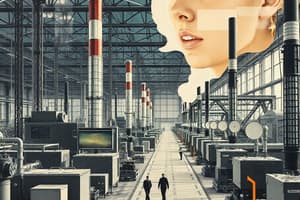Podcast
Questions and Answers
Which of the following best describes the primary function of a 'Smart Factory' within the context of Industry 4.0?
Which of the following best describes the primary function of a 'Smart Factory' within the context of Industry 4.0?
- To solely focus on reducing labor costs through automation.
- To create an isolated production environment with minimal external connections.
- To establish a highly integrated and interconnected production environment that leverages advanced technologies. (correct)
- To maximize the use of traditional manufacturing processes without incorporating digital technologies.
In a smart factory, how does interconnectivity primarily enhance the manufacturing processes?
In a smart factory, how does interconnectivity primarily enhance the manufacturing processes?
- By restricting access to critical data to only a few key personnel.
- By enabling real-time data exchange and collaboration between different systems. (correct)
- By isolating each machine to prevent system-wide failures.
- By reducing the reliance on automation and increasing manual labor.
How do smart factories utilize data to optimize operations and predict maintenance needs?
How do smart factories utilize data to optimize operations and predict maintenance needs?
- By analyzing data using advanced analytic tools to identify trends. (correct)
- By using intuition and past experiences to make decisions.
- By relying solely on manual inspections to detect anomalies.
- By disregarding the vast amounts of data collected from sensors and machines.
In the context of smart factories, what does 'Cyber-Physical Integration' primarily involve?
In the context of smart factories, what does 'Cyber-Physical Integration' primarily involve?
In what way do smart factories contribute to sustainability?
In what way do smart factories contribute to sustainability?
What is the role of 'Actuators' as physical components in Cyber-Physical Systems (CPS)?
What is the role of 'Actuators' as physical components in Cyber-Physical Systems (CPS)?
How do Cyber-Physical Systems (CPS) primarily enhance human-machine collaboration in Industry 4.0?
How do Cyber-Physical Systems (CPS) primarily enhance human-machine collaboration in Industry 4.0?
What role does real-time monitoring play in Cyber-physical systems?
What role does real-time monitoring play in Cyber-physical systems?
Which of the following is the most accurate description of a 'Smart City'?
Which of the following is the most accurate description of a 'Smart City'?
What is the primary role of Information and Communication Technology (ICT) infrastructure in a Smart City?
What is the primary role of Information and Communication Technology (ICT) infrastructure in a Smart City?
How do Smart Cities leverage data analytics to improve urban environments?
How do Smart Cities leverage data analytics to improve urban environments?
What is the purpose of 'Citizen Engagement' in the context of Smart Cities?
What is the purpose of 'Citizen Engagement' in the context of Smart Cities?
How do smart cities implement sustainable practices?
How do smart cities implement sustainable practices?
Which aspect of Dubai's Smart City initiatives does the 'Dubai Electricity and Water Authority (DEWA)' primarily focus on?
Which aspect of Dubai's Smart City initiatives does the 'Dubai Electricity and Water Authority (DEWA)' primarily focus on?
What distinguishes Masdar City as a Smart City initiative in Abu Dhabi?
What distinguishes Masdar City as a Smart City initiative in Abu Dhabi?
Flashcards
What is a Smart Factory?
What is a Smart Factory?
A highly integrated and interconnected production environment using technologies like CPS, AI, and IoT to create an intelligent and autonomous manufacturing system.
Interconnectivity
Interconnectivity
Machines, devices, and sensors are seamlessly connected through wired or wireless networks, enabling real-time data exchange and collaboration.
Data-Driven Decision Making
Data-Driven Decision Making
Smart factories collect vast amounts of data which is analyzed using advanced analytics tools to identify trends, optimize operations, and predict maintenance needs.
Cyber-Physical Integration
Cyber-Physical Integration
Signup and view all the flashcards
Advanced Automation
Advanced Automation
Signup and view all the flashcards
Flexibility and Agility
Flexibility and Agility
Signup and view all the flashcards
Sustainability
Sustainability
Signup and view all the flashcards
Increased Productivity and Efficiency
Increased Productivity and Efficiency
Signup and view all the flashcards
Improved Quality Control
Improved Quality Control
Signup and view all the flashcards
Enhanced Safety
Enhanced Safety
Signup and view all the flashcards
Reduced Costs
Reduced Costs
Signup and view all the flashcards
Greater Innovation
Greater Innovation
Signup and view all the flashcards
What are Cyber-Physical Systems (CPS)?
What are Cyber-Physical Systems (CPS)?
Signup and view all the flashcards
What is a Smart City?
What is a Smart City?
Signup and view all the flashcards
Study Notes
- Industry Revolution 4.0 encompasses smart factories, cyber-physical systems, and smart cities.
Smart Factories: The Powerhouse of Industry 4.0
- A smart factory is a highly integrated and interconnected production environment.
- It utilizes Cyber-Physical Systems (CPS), Artificial Intelligence (AI), and the Internet of Things (IoT) for intelligent, autonomous manufacturing.
- The vision is a factory where machines, robots, and data work together to optimize production.
Key Principles of Smart Factories
- Interconnectivity allows real-time data exchange and collaboration via wired or wireless networks.
- Data-Driven Decision Making involves analyzing vast amounts of data from sensors to identify trends, optimize operations, and predict maintenance needs.
- Cyber-Physical Integration: physical machinery integrates with computational capabilities to monitor performance and make autonomous decisions.
- Advanced Automation: Robots and other automation technologies handle repetitive tasks, complex operations, and collaborate with human workers.
- Flexibility and Agility is achieved by real-time data analysis and ability to reconfigure production lines quickly and efficiently.
- Sustainability involves optimizing resource utilization, reducing waste, and integrating renewable energy sources.
Benefits of Smart Factories
- Increased Productivity and Efficiency results from optimized processes, reduced downtime, and real-time decision-making.
- Improved Quality Control is enabled by real-time monitoring and data analysis, allowing for early detection of defects.
- Enhanced Safety results from advanced automation and human-machine collaboration, which removes workers from hazardous tasks.
- Reduced Costs is achieved through lower energy consumption, optimized resource usage, and predictive maintenance.
- Greater Innovation: Data-driven insights and increased agility can fuel innovation in product design, manufacturing processes, and business models.
Real-World Examples of Smart Factories
- Tesla Gigafactory (Berlin): Uses AI and cloud technologies in its electric vehicle production to automate intelligently and enhance sustainability.
- Alibaba (Hangzhou, China): Employs cloud computing and IoT in its fashion-and-apparel manufacturing for agile production, AI-enabled cutting machines, and networked sewing equipment.
- Saudi Aramco (Saudi Arabia): Khurais oil field utilizes 40,000+ sensors monitoring oil wells, using big-data analytics, AI, robotics, and digital twins for efficient operations.
Cyber-Physical Systems (CPS): The Brains Behind Industry 4.0
- Cyber-Physical Systems (CPS) bridge the physical world of machinery and digital data, integrating physical machinery with computational capabilities.
- CPS Definition: Intelligent machines integrate physical machinery with computational capabilities, enabling them to collect data, monitor performance, communicate, and make autonomous decisions.
- This integration helps improve automation, efficiency, and control in industrial processes.
Main Components of CPS
- Physical Components: Tangible parts of the system:
- Sensors capture data (temperature, pressure, vibration).
- Actuators convert digital signals into physical actions (controlling motors or valves).
- Machines & Equipment core industrial machinery (robots, assembly lines, power generators).
- Computational Components: "Brain" of the system:
- Microcontrollers collect data from sensors and control actuators.
- Software analyzes sensor data, makes decisions, and communicates.
- Communication Protocols are standardized methods to exchange data.
- Network Connectivity: Wired (Ethernet) or wireless (Wi-Fi, Bluetooth) connects communication networks.
The Power of CPS in Industry 4.0
- Real-time Monitoring: CPS continuously monitor machinery to identify problems.
- Data-Driven Decision Making: Analysis of large data sets to improve resource allocation.
- Autonomous Control: Advanced CPS make autonomous decisions based on real-time data.
- Enhanced Human-Machine Collaboration: CPS work alongside humans, giving insights to improve decision-making and safety.
Smart Cities: The Evolving Landscape of Industry 4.0
- Industry 4.0 is also transforming cities via Smart Cities, which utilize technology to create efficient, sustainable, and citizen-centric urban environments.
- A Smart City definition is a network of interconnected devices, sensors, and data analytics for optimized city functions, services, and infrastructure.
- This creates a responsive urban ecosystem that benefits citizens/environment.
Main Components of Smart Cities
- Information and Communication Technology (ICT) Infrastructure forms the backbone, providing a network for data collection, communication, and analysis (high-speed internet, cloud computing, sensor networks).
- Data Analytics involves the analysis of data collected from sensors, traffic systems, and citizen engagement platforms to identify trends and predict problems.
- Citizen Engagement involves interactive platforms, mobile apps, and open data initiatives.
- Sustainable Practices aim to reduce environmental impact through optimizing energy use, waste management, and green transportation.
Examples of Smart City Initiatives in the UAE
- Dubai is a global leader in Smart City initiatives, aiming to be 10 years ahead of other cities via its "Dubai 10X" vision.
- The Dubai Electricity and Water Authority (DEWA) utilizes smart meters and AI for energy optimization and waste reduction.
- The Roads and Transport Authority (RTA) implements smart traffic management systems and sustainable transportation options.
- Abu Dhabi is also embracing Smart City initiatives:
- Masdar City is a sustainable city using renewable energy sources and promoting energy-efficient buildings.
- The Integrated Transport Centre (ITC) provides a platform for managing public transportation systems across the emirate.
Studying That Suits You
Use AI to generate personalized quizzes and flashcards to suit your learning preferences.




